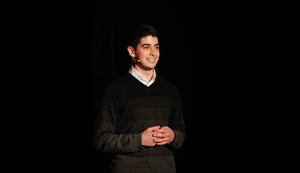
India is a country where tens of millions of people don’t have access to a trained health professional that can give them basic health and wellness advice. The Bangalore-based mobile services company mDhil wants to change that.
印度极其缺乏训练有素的医疗专家,几千万人无法获得基本的卫生和健康咨询服务。总部位于班加罗尔的移动服务公司mDhil希望能够改变这种状况。
“India faces a tremendous shortage of doctors,” says Nandu Madhava, the Texas-raised, Harvard-educated social entrepreneur who started mDhil in 2009. “People would turn to quacks and old myths for health information that is rarely grounded in any science. We’re working to alleviate that problem.”
“医生极度匮乏是印度面临的一个老大难问题,”南渡o玛达瓦说。这位在德州长大,毕业于哈佛大学(Harvard University)的社会企业家于2009年创办了mDhil公司。“人们经常通过江湖郎中和古老的神话来获取几乎没有任何科学依据的健康信息。我们正在努力缓解这一问题。”
Madhava’s company started as an SMS messaging service where people paid for advice, but the approach failed to scale beyond a subscriber base of about 250,000. Two years ago, Madhava, a 40ish American expat of Indian origin, decided to take a different tack.
玛达瓦的公司起初从事有偿医疗短信服务,但这种方式无法推动用户群在达到大约25万人之后继续增长。两年前,这位40岁左右的印度裔美国人决定采取另一种策略。
“With a shift to 3G networks and low cost phones with mobile browsers, we made a strategic decisions to focus on mobile videos,” says Madhava, who worked for the Peace Corps and Goldman Sachs before launching mDhil.
玛达瓦说:“随着用户转向3G网络,纷纷使用配备移动浏览器的低成本手机,我们做出了一个专注于移动视频的战略决策。”创办mDhil之前,玛达瓦曾任职于和平队(Peace Corps)和高盛公司(Goldman Sachs)。
mDhil has since reached 20 million video views globally, fueled by a strong preference by people in the developing world—far stronger than in the developed world–for services optimized for mobile devices.
自那以后,mDhil的全球浏览量已经达到2,000万次,主要推动力之一是发展中国家民众对面向移动设备的优化服务有着强烈的偏好——这种偏好远大于发达国家。
“This makes a lot of business sense as most Indians connect to the Internet through their mobile phones,” says Katyayan Gupta, an eBusiness and channel strategy analyst at Forrester Research in New Delhi, India. “In most developing countries, including Brazil or China, Internet companies have to be mobile-first. I see this trend soon becoming the norm.”
“这种做法颇具商业头脑,因为大多数印度人是通过手机上网的,”常驻印度新德里的弗雷斯特研究公司(Forrester Research)电子商务和渠道策略分析师卡蒂亚扬o古普塔说。“在大多数发展中国家,包括巴西和中国,互联网公司必须采用移动优先原则。我认为这种趋势很快就会成为常态。”
Sandy Shen, a research director with Gartner in Shanghai, concurs. “Mobile is a top priority for many providers looking for future growth, she says, “and this is an area where lots of innovation is happening.”
上海高德纳咨询公司(Gartner) 研究总监桑迪o沈赞同这种观点。“移动应用是许多寻求未来增长的服务提供商最优先考虑的方向,”她说。“这个领域的创新层出不穷。”
At present about 65 percent of mDhil’s traffic comes from mobile devices, but that figure is expected to grow to 90 percent in just two years. Since dropping its subscription model, the company leverages its partnership with YouTube and other online channels to make money from advertising, licensing, and sponsorships.
mDhil目前约有65%的流量来自移动设备,但在仅仅两年后,这个数字预计就将增长到90%。自从放弃订阅模式以来,这家公司利用它跟YouTube和其他在线渠道结成的合作关系,通过广告、许可使用和赞助等方式来获得收入。
“Their main revenue model is to charge for ads and not the consumer,” Gupta says. “This is a common practice. Facebook follows the same approach.”
“他们的主要收入来源是广告商,而不是消费者,”古普塔说。“这是一种常见的做法。Facebook也采用相同的策略。”
By making the service essentially free at the front end, apart from the cost of Internet access, mDhil has been able to quickly scale to millions of users. It gauges the effectiveness of its advice in a number of ways.
这样一来,除了上网费,前端用户基本上无需支付任何费用。依凭这种方式,mDhil迅速赢得了数百万用户。这家公司通过多种方式来评估医疗建议的有效性。
“If we create great videos, we get more users both in terms of watch time and social media activity,” Madhava says.
玛达瓦说:“如果我们创作了非常优质的视频,无论是根据观看时间还是根据社交媒体活跃度来观察,我们都会获得更多的用户。”
For example, women felt better informed after watching videos on subjects such as puberty, reproductive health, and birth control, according to field studies mDhil performed in conjunction with urban NGOs.
例如,根据mDhil联合多家城市非政府组织所做的实地研究,在观看了诸如青春期、生殖健康和节育等主题的视频之后,妇女的健康意识显著增强。
It’s of particular importance in India, where long-standing cultural taboos discourage the creation and distribution of high-quality health content in local Indian languages.
这一点在印度具有特别重要的意义,因为这个国家长期存在的文化禁忌阻止使用当地语言创造和传播高品质的健康内容。
And as for a developed market where this is less of a factor? mDhil “absolutely” has a chance of being a hit in the United States, Madhava says. “We’ve started creating health and wellness content with a global audience in mind.”
那么,mDhil能否在一个并不存在这种禁忌的发达国家市场获得成功呢?mDhil“绝对”有机会风靡美国,玛达瓦说。“我们已经开始制作面向全球观众的卫生和健康内容。”
Some of mDhil’s newest online video channels receive 80 percent of their viewership from people in the U.S. and Europe, Madhava says. (The subject matter and tone is different from the company’s India-focused content—you can see examples here and here—but Madhava stresses that mDhil’s Bangalore team can produce videos for audiences in the developed world for a fraction of what it would cost in the West.)
玛达瓦说,在mDhil最新推出的一些网络视频渠道中,有80%的浏览量来自美国和欧洲。(这些视频的主题和风格有别于这家公司面向印度市场推出的内容,但玛达瓦强调,mDhil的班加罗尔团队能够生产面向发达国家观众的视频,而且花费仅仅是在西方国家制作同类视频成本的一小部分。)
But India sits at the center of Madhava’s mission. “It’s going to take entrepreneurs to help build this country into all that it can be,” he says.
不过,印度仍然在这家公司的使命中占据着中心位置。他说:“这个国家需要一些企业家来帮助它实现潜能。”


